Gen AI & Design Thinking
Generative AI and Design Thinking: revolutionizing innovation together
Generative AI is rapidly reshaping how design teams and tech leaders approach innovation. When combined with Design Thinking, it creates a potent alliance: human-centered creativity meets machine-driven speed and scale.
This isn’t about replacing designers, it’s about supercharging their process. From deeper user insights to faster prototyping and smarter testing, AI is transforming how we move from problem to solution.
In this article, we unpack how Generative AI integrates into each phase of the Design Thinking framework and why the future of innovation belongs to those who know how to harness both human and artificial intelligence.
What is Generative AI?
Generative AI marks a major shift in how we think about creativity and problem-solving. It refers to models that create original content – such as text, images, code, video and more – by learning from vast datasets. Unlike traditional AI, which focuses on analysis or prediction, Generative AI is built to produce. Tools like ChatGPT, DALL·E, Midjourney and Runway are already enabling people across industries to brainstorm faster, visualize ideas more clearly and automate creative tasks. Rather than replacing creativity, generative AI enhances it by combining two unique sets of capabilities: the strategic intuition of humans and the computational power of machines. Together, they offer a new edge in solving problems and bringing ideas to life.
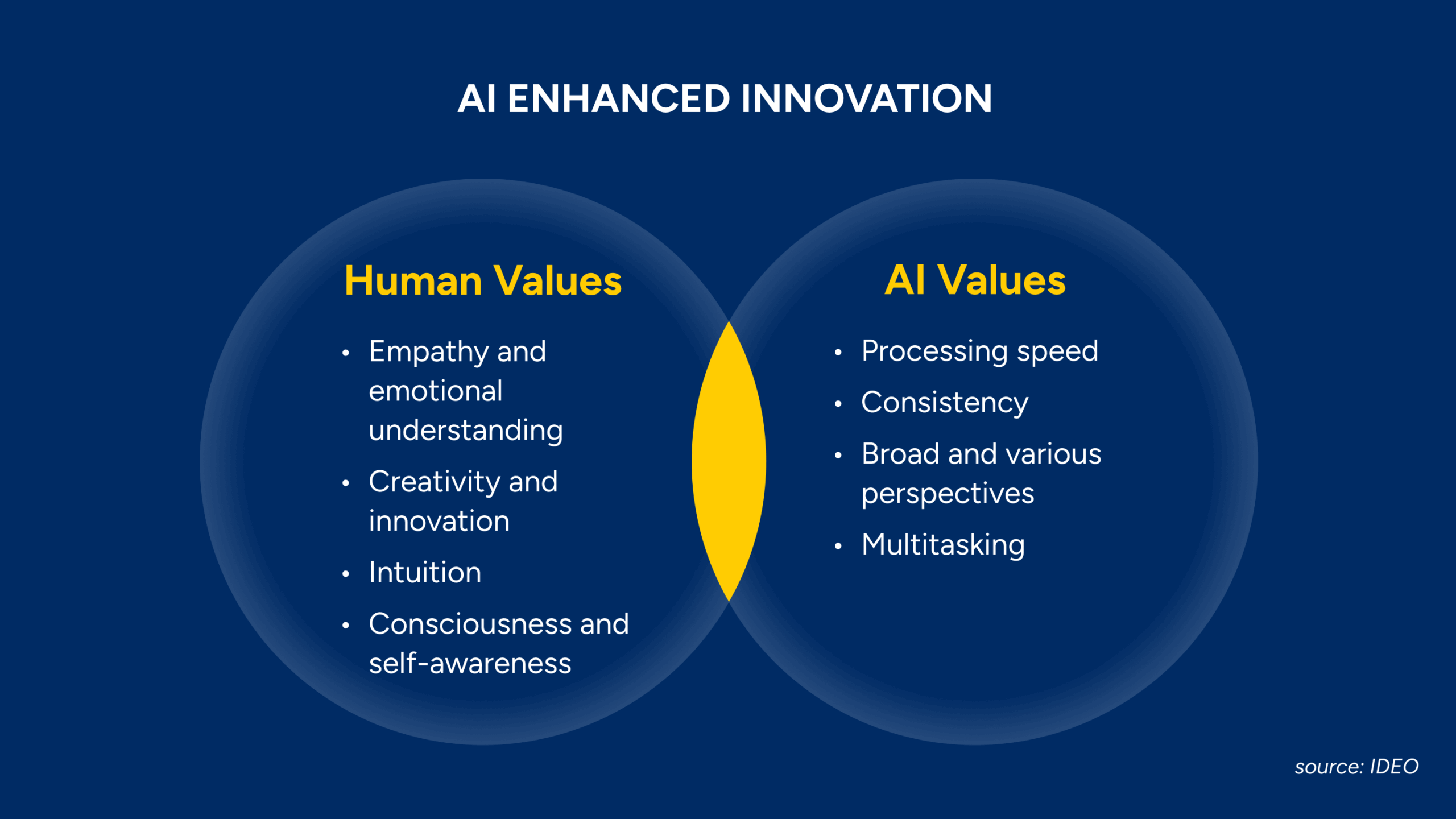
Where does Design Thinking come from and how has it changed innovation?
Design Thinking has its roots in the mid-20th century, when thinkers like Herbert Simon began framing design as a structured approach to solving complex problems. But it truly took off in the 1990s when firms like IDEO started applying design methods to business and innovation challenges. Later, the Hasso Plattner Institute of Design at Stanford University (known as d.school) helped formalize this approach and scale it across industries and education.
What started as a methodology for designers has become a powerful framework for innovation across sectors, from healthcare and education to fintech and urban planning. Its human-centered, iterative approach helps teams uncover real user needs, reframe challenges and test ideas early and often.
Design Thinking has shifted the innovation playbook. It has moved the focus away from solution-first thinking toward a deeper understanding of users; guided by empathy, collaboration and continuous learning.
Now with the rise of Generative AI we’re entering a new phase of innovation, one that combines human insight with machine-powered creativity and speed.

How can AI help innovate services and products?
Despite its limitations, AI is a powerful catalyst for innovation. It empowers not just designers and developers but teams and individuals too, allowing them to explore new possibilities, make better decisions and deliver smarter, more human-centered outcomes.
AI as Creative Collaborator
Generative AI opens new avenues for creative expression. It can:
- Generate original content: Images, text, music and video – all based on trained data patterns.
- Enhance ideation: Provide prompts, variations and unexpected combinations.
- Support brainstorming: Act as a thought partner to push ideas beyond the obvious.
This turns AI into a real-time creative partner that expands the idea space, which is especially useful during ideation and early concept development.
Augmenting Human Intuition with Data
- AI brings clarity to messy, ambiguous innovation processes by:
Analyzing large datasets faster than any team could. - Spotting patterns and correlations that inform strategic decisions.
- Identifying early signals from user feedback, behavior and market trends.
This helps innovators make more confident, evidence-based decisions without replacing their creative judgment.
Combinatorial and Adaptive Creativity
AI excels at recombining ideas in novel ways; mixing styles, formats and concepts to generate entirely new directions. It also adapts to feedback, learning from outcomes to refine results, which makes it ideal for iterative design processes.
Bridging Gaps in Capabilities
Generative tools like ChatGPT, Midjourney or Uizard make sophisticated design and ideation accessible to non-experts. This democratizes creativity and allows cross-functional teams – from marketers to product owners – to contribute meaningfully to innovation.
Accelerating Empathy-Driven Leadership
When used ethically, AI enables a faster, deeper understanding of user needs. From sentiment analysis to persona generation, it saves time and enriches insight; engendering more empathetic, responsive leadership in service and product design.
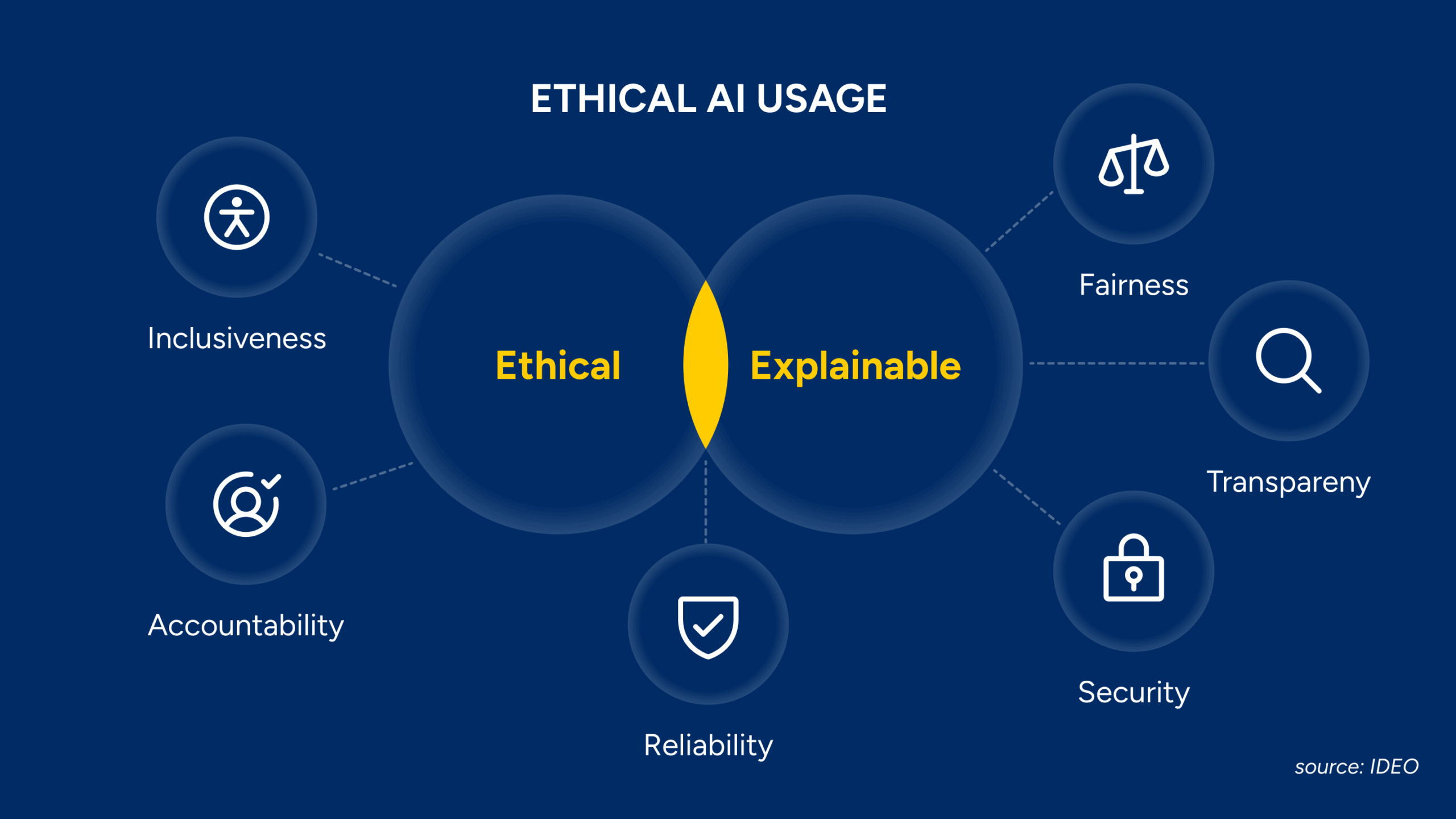
Possibilities of AI in the Double Diamond
The Double Diamond framework Discover, Define, Develop and Deliver guides Design Thinking through four iterative phases of problem-solving and solution-building. AI enhances each stage by accelerating research, expanding creative range and improving iteration depth and precision.
First Diamond Phase “Discover & Define the problem”
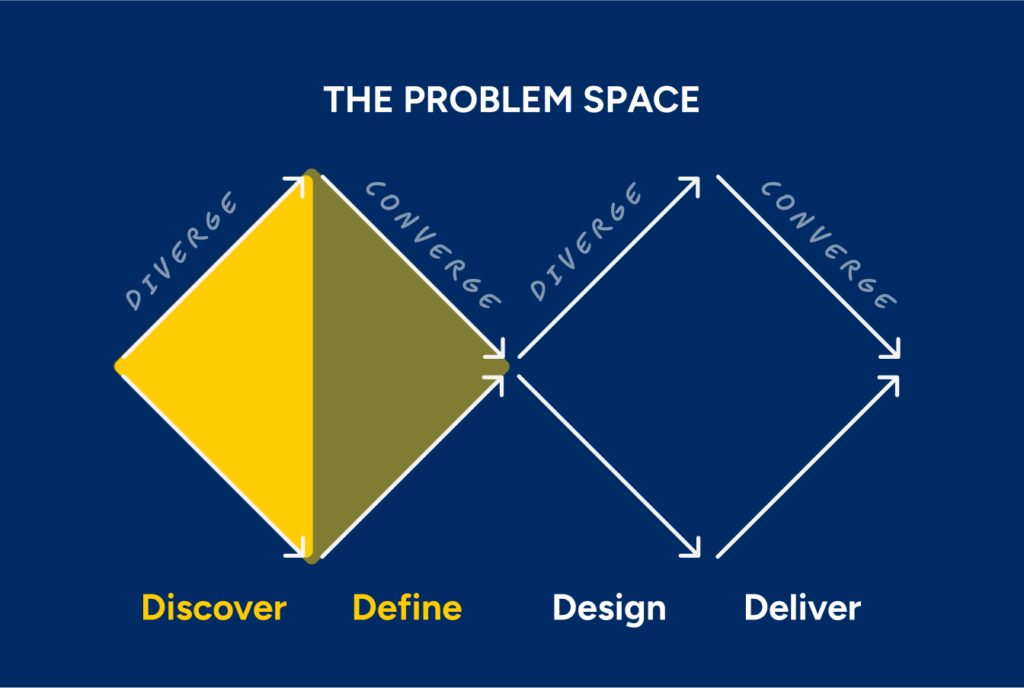
First Diamond Phase “Discover & Define the problem”
This phase is about exploring user needs and framing the right challenge. AI supports by:
- Broadening Perspectives: AI can process vast data sets, identify behavioral patterns and simulate user interactions, helping teams uncover insights that may not surface through manual research alone.
- Uncovering Hidden Connections: It structures disorganized inputs, detects relationships in data and helps synthesize findings into meaningful insights and problem statements.
- Envisioning Future Scenarios: AI-powered forecasting tools can model potential futures, identify emerging trends and support more strategic problem framing.
source: (HPI d-school)
Second Diamond Phase “Develop & Deliver the solution”
In this phase, once the problem is clearly defined the focus shifts to generating, refining and testing ideas. AI helps by:
- Generating Diverse Solutions: AI can generate and cluster ideas based on user needs, data trends and market benchmarks. It also helps define evaluation criteria to assess potential directions objectively.
- Accelerating Prototyping: Tools like Bolt.new, Subframe.com and stitch.withgoogle translate abstract ideas into concrete visuals or interactive prototypes, making design more accessible across teams and reducing time to concept.
- Optimizing Through Feedback: AI creates test scenarios, simulates user interactions and analyzes feedback to guide rapid iteration and continuous improvement.
By integrating AI into the Double Diamond process teams can move faster from insight to impact, making Design Thinking more scalable, efficient and insight-driven than ever before.
source: (HPI d-school)
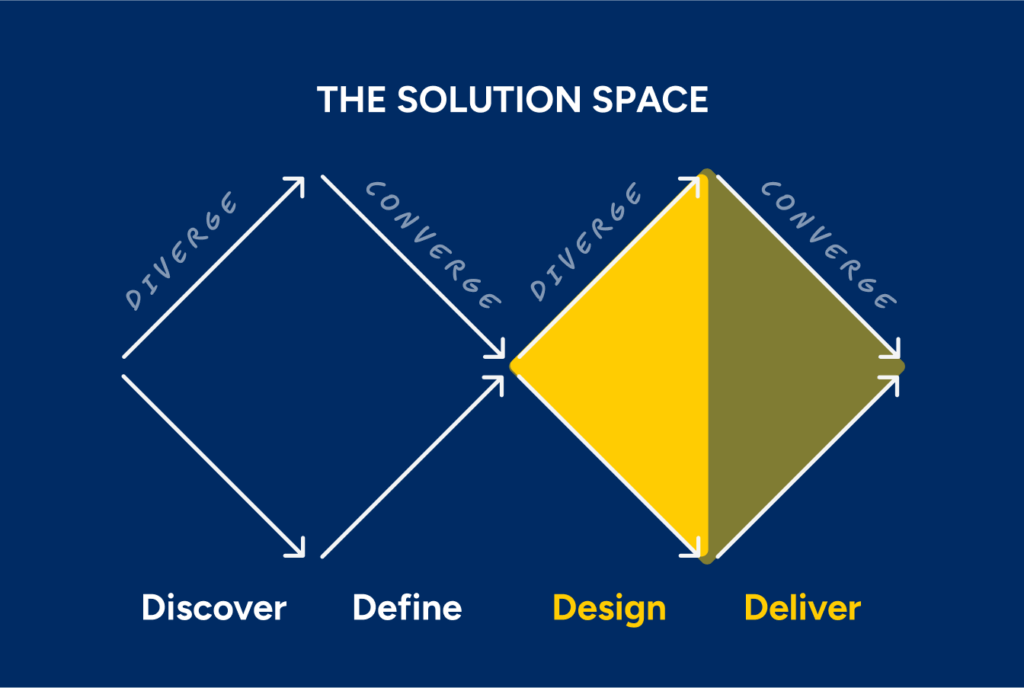
Second Diamond Phase “Develop & Deliver the solution”

In this phase, once the problem is clearly defined the focus shifts to generating, refining and testing ideas. AI helps by:
- Generating Diverse Solutions: AI can generate and cluster ideas based on user needs, data trends and market benchmarks. It also helps define evaluation criteria to assess potential directions objectively.
- Accelerating Prototyping: Tools like Bolt.new, Subframe.com and stitch.withgoogle translate abstract ideas into concrete visuals or interactive prototypes, making design more accessible across teams and reducing time to concept.
- Optimizing Through Feedback: AI creates test scenarios, simulates user interactions and analyzes feedback to guide rapid iteration and continuous improvement.
By integrating AI into the Double Diamond process teams can move faster from insight to impact, making Design Thinking more scalable, efficient and insight-driven than ever before.
source: (HPI d-school)
AI bypassing ideation bottlenecks
AI bypassing ideation bottlenecks
AI revolutionizes the ideation phase of Design Thinking. By leveraging AI, teams can accelerate the process of generating new and innovative ideas, effectively bypassing the initial, less productive stages often associated with “simple” or “obvious” ideas, and instead jump directly into exploring truly novel and “crazy” concepts.

Practical tips for integrating AI into each double diamond phase
Harnessing AI’s power effectively requires more than just having the tools. It demands knowing how to apply them strategically throughout the Design Thinking process. The following tips offer actionable guidance to teams for maximizing AI’s impact at each stage of the Double Diamond, blending technology with human-centered design practices.
This might be the first time where prototyping feels like prototyping for real – and not just showing intent. We are very excited to try it out in our working flow.
Tip #1 Discover (Empathize): build on established methods & frameworks
![A partial view of a slide or document detailing steps for design thinking, specifically "1. Empathize (Understanding the Problem)" and "2. Define (Narrow Down the Problem)." A prompt in the foreground reads: "Prompt: Provide me with a list of suitable design thinking methods to solve [X] in [Y] hours."](https://ennostudio.com/wp-content/uploads/2025/07/ennostudio_blogpost_generative_ai_and_design_thinking_tip_in_discover_empathize-1024x684.png)
Tip #1 Discover (Empathize): build on established methods & frameworks
Classic Design Thinking frameworks remain vital. AI doesn’t replace these tried-and-true structures, it accelerates the action of filling them with insights. Use AI to analyze large data sets, generate user personas and uncover hidden patterns, but anchor your work in human-centered methods that have been refined over decades.
Tip #2 Define: Let AI handle the “manual tasks'” and generate inspirational assets
Workshop preparation can be tedious. Use AI tools like ChatGPT to draft workshop materials, identify emerging trends or generate idea prompts and inspiration cards. This frees you to focus on framing the right problem rather than scrambling for content.
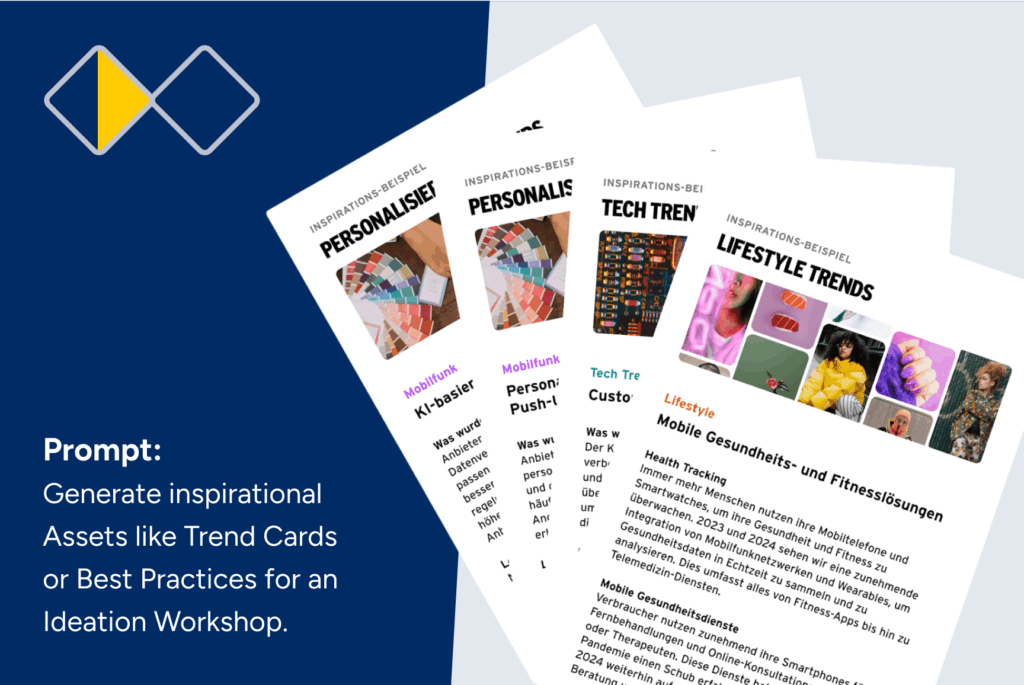
Tip #2 Define: Let AI handle the “manual tasks'” and generate inspirational assets

Workshop preparation can be tedious. Use AI tools like ChatGPT to draft workshop materials, identify emerging trends or generate idea prompts and inspiration cards. This frees you to focus on framing the right problem rather than scrambling for content.
Tip #3 Develop (Ideate & Prototype): visualize and bring ideas to life quickly
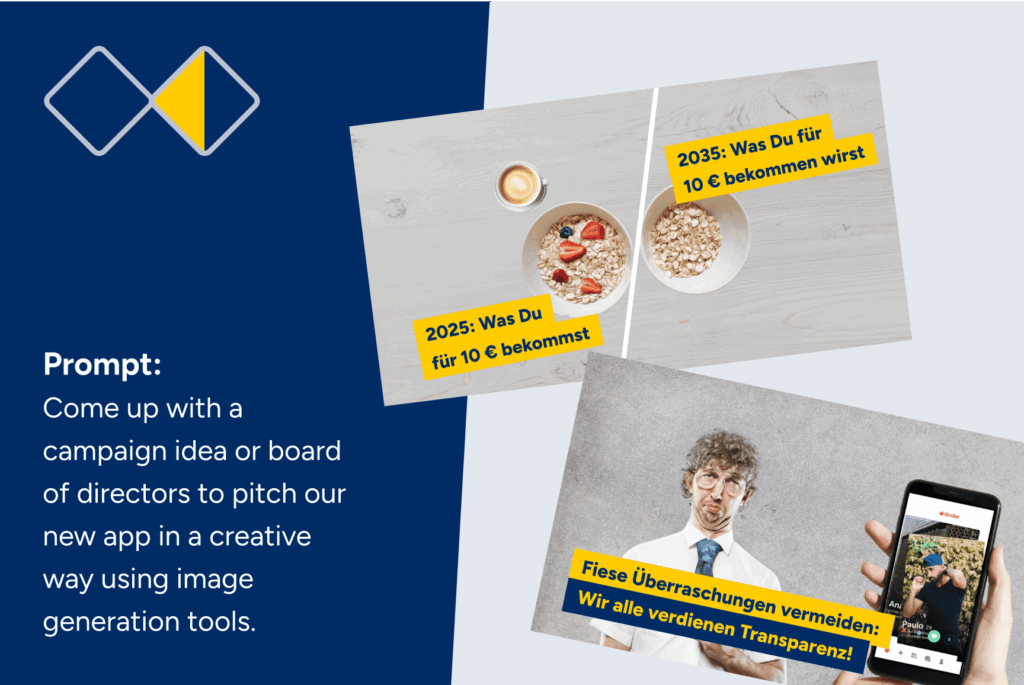
Tip #3 Develop (Ideate & Prototype): visualize and bring ideas to life quickly
Non-designers often hesitate to visualize their ideas. AI-powered tools like Bolt.new, Subframe or Stitch lower these barriers by enabling everyone to effortlessly create compelling visuals and prototypes. Making ideas tangible fosters clearer communication and more confident iteration.
Tip #4 Deliver (Test & Iterate): automate test concept creation and scenario planning
Testing and iteration are resource-intensive. AI can draft test plans, suggest methods tailored to your prototypes and sharpen your screening questions for user recruitment. It also generates realistic test scenarios to reveal potential issues early, so you can focus on analysis and improvements.
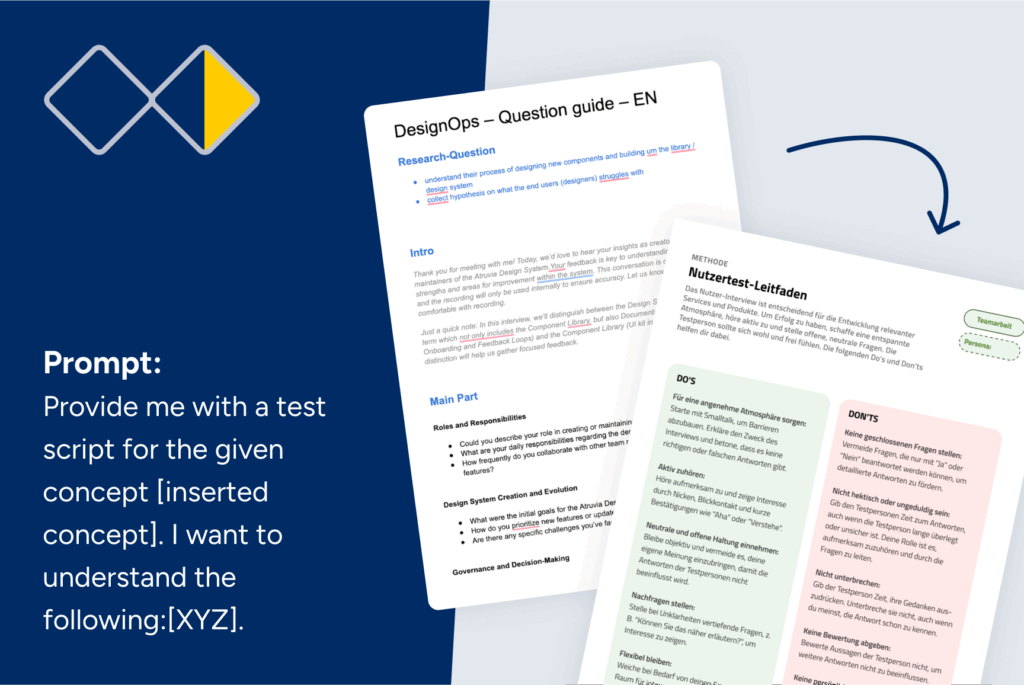
Tip #4 Deliver (Test & Iterate): automate test concept creation and scenario planning

Testing and iteration are resource-intensive. AI can draft test plans, suggest methods tailored to your prototypes and sharpen your screening questions for user recruitment. It also generates realistic test scenarios to reveal potential issues early, so you can focus on analysis and improvements.
Limitations of AI in Design Thinking
While Generative AI is transforming how we ideate, test and build, it’s not a silver bullet. Especially in the context of Design Thinking where AI comes with real limitations that require human judgment, empathy and critical thinking to overcome.
1. Garbage In, Garbage Out: AI is only as good as the data it’s trained on. Poor-quality, incomplete or biased data can lead to misleading insights or flawed product decisions. When tackling novel or disruptive problems where little historical data exists, AI may fall short.
2. Linear Logic, Non-linear Problems: AI is great at optimizing within existing patterns, but struggles when problems require nonlinear thinking, intuition or reframing. Design Thinking thrives on ambiguity, empathy and surprising connections; areas where AI still lags.
3. Lack of Empathy: Design Thinking puts human needs at the center. Yes, AI can analyze behavior, but it doesn’t feel. It can’t interpret cultural nuance, emotional context or the unspoken motivations behind user behavior.
4. Ethical and Privacy Risks: AI systems that personalize services or simulate user interactions need to be carefully managed to protect user privacy. Unchecked algorithmic bias can reinforce stereotypes or exclude vulnerable groups.
5. Creativity Within Constraints: AI can remix what already exists, but it struggles with true originality. While it’s a powerful partner for idea generation, it rarely produces groundbreaking or paradigm-shifting ideas without human provocation.

Conclusion
Generative AI is a powerful co-pilot that enhances creativity, speeds up innovation and expands what’s possible. It doesn’t replace human designers but amplifies their capabilities. To truly unlock its potential teams must stay human-centered, use AI responsibly and combine technological power with ethical judgment – human oversight is essential. Those who embrace AI thoughtfully will shape the future, those who don’t risk being left behind.

We are a design and innovation studio creating engaging, accessible digital experiences for everyone. Our team of product designers and strategic consultants combine beautiful design and creative strategies to build and promote user interfaces that make a real difference to people’s lives.
Jetzt abonnieren
Unser Newsletter liefert exklusive Einblicke, spannende UX-Insights und aktuelle Projekt-Updates direkt in Ihr Postfach.
